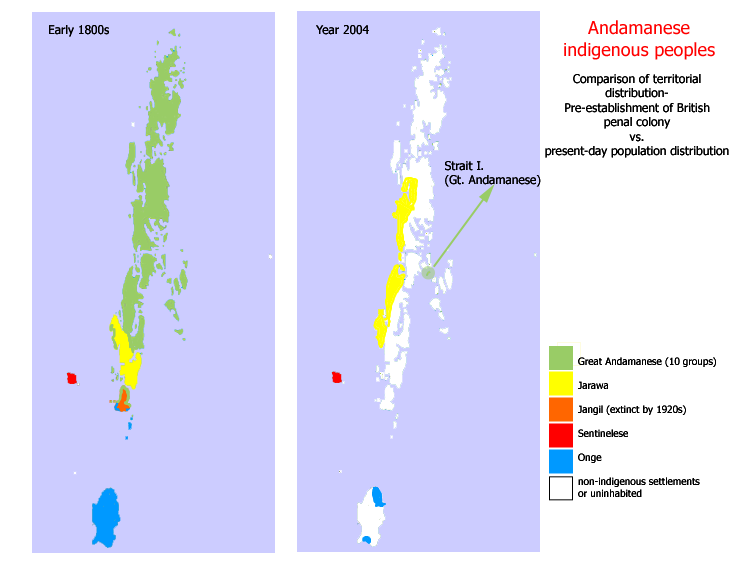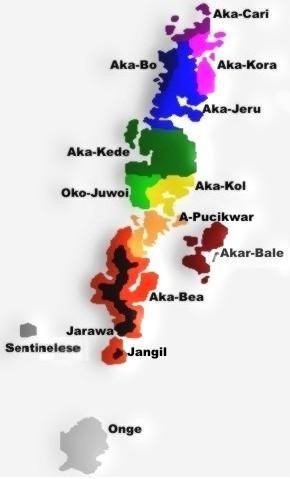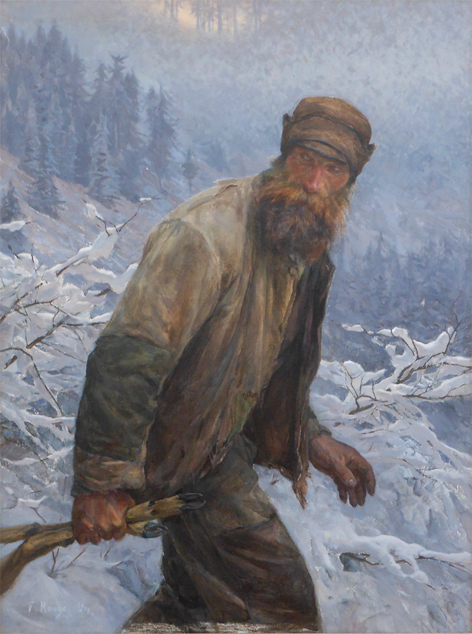|
Jarawa (Andaman Islands)
The Jarawas (Jarawa: ''Aong'', ) are an indigenous people of the Andaman Islands in India. They live in parts of South Andaman and Middle Andaman Islands, and their present numbers are estimated at between 250–400 individuals. They have largely shunned interaction with outsiders, and many particulars of their society, culture and traditions are poorly understood. Since the 1990s, contacts between Jarawa groups and outsiders grew increasingly frequent. By the 2000s, some Jarawas had become regular visitors at settlements, where they trade, interact with tourists, get medical aid, and even send their children to school. The Jarawas are recognised as an Adivasi group in India. Along with other indigenous Andamanese peoples, they have inhabited the islands for several thousand years. The Andaman Islands have been known to outsiders since antiquity; however, until quite recent times they were infrequently visited, and such contacts were predominantly sporadic and temporary. For th ... [...More Info...] [...Related Items...] OR: [Wikipedia] [Google] [Baidu] |
South Andaman Island
South Andaman Island is the southernmost island of the Great Andaman and is home to the majority of the population of the Andaman Islands. It belongs to the South Andaman administrative district, part of the Indian union territory of Andaman and Nicobar Islands. It is the location of Port Blair, capital of the Andaman and Nicobar Islands. History South Andaman Island was struck by the 2004 Indian Ocean earthquake, leading to many deaths on the island. Geography The island belongs to the Great Andaman Chain. Some areas of the island are restricted areas for non-Indians; however, transit permits can be obtained from the Home Ministry. South Andaman is the third largest island in the island group. It is located immediately south of Middle Andaman Island and Baratang, from which it is separated only by a narrow channel, a few hundred meters wide. The island is long and at its widest part. Its area is . South Andaman is less mountainous than the more northerly of the Andaman Isla ... [...More Info...] [...Related Items...] OR: [Wikipedia] [Google] [Baidu] |
Great Andamanese
The Great Andamanese are an indigenous people of the Great Andaman archipelago in the Andaman Islands. Historically, the Great Andamanese lived throughout the archipelago, and were divided into ten major tribes. Their distinct but closely related languages comprised the Great Andamanese languages, one of the two identified Andamanese language families. The Great Andamanese were clearly related to the other Andamanese peoples, but were well separated from them by culture and geography. The languages of those other four groups were only distantly related to those of the Great Andamanese and mutually unintelligible; they are classified in a separate family, the Ongan languages. They were once the most numerous of the five major groups in the Andaman Islands with an estimated population between 2,000 and 6,600, the Great Andamanese were heavily decimated by diseases, alcohol, colonial warfare and loss of hunting territory. Only 52 remained as of February 2010; by August 2020 there ... [...More Info...] [...Related Items...] OR: [Wikipedia] [Google] [Baidu] |
Calcutta High Court
The Calcutta High Court is the oldest High Court in India. It is located in B.B.D. Bagh, Kolkata, West Bengal. It has jurisdiction over the state of West Bengal and the Union Territory of the Andaman and Nicobar Islands. The High Court building's design is based on the Cloth Hall, Ypres, in Belgium. It is the oldest high court in India. Currently, the court has a sanctioned judge strength of 72. History The Calcutta High Court is one of the three High Courts in India established at the Presidency Towns by Letters patent granted by Queen Victoria, bearing date 26 June 1862, and is the oldest High Court in India. It was established as the High Court of Judicature at Fort William on 1 July 1862 under the High Courts Act, 1861, which was preceded by the Supreme Court of Judicature at Fort William. The building structure was designed by Walter Long Bozzi Granville. Despite the name of the city having officially changed from Calcutta to Kolkata in 2001, the Court, as an ins ... [...More Info...] [...Related Items...] OR: [Wikipedia] [Google] [Baidu] |
Poaching
Poaching has been defined as the illegal hunting or capturing of wild animals, usually associated with land use rights. Poaching was once performed by impoverished peasants for subsistence purposes and to supplement meager diets. It was set against the hunting privileges of nobility and territorial rulers. Since the 1980s, the term "poaching" has also been used to refer to the illegal harvesting of wild plant species. In agricultural terms, the term 'poaching' is also applied to the loss of soils or grass by the damaging action of feet of livestock, which can affect availability of productive land, water pollution through increased runoff and welfare issues for cattle. Stealing livestock as in cattle raiding classifies as theft, not as poaching. The United Nations' Sustainable Development Goal 15 enshrines the sustainable use of all wildlife. It targets the taking of action on dealing with poaching and trafficking of protected species of flora and fauna to ensure their avail ... [...More Info...] [...Related Items...] OR: [Wikipedia] [Google] [Baidu] |
Measles
Measles is a highly contagious infectious disease caused by measles virus. Symptoms usually develop 10–12 days after exposure to an infected person and last 7–10 days. Initial symptoms typically include fever, often greater than , cough, runny nose, and inflamed eyes. Small white spots known as Koplik's spots may form inside the mouth two or three days after the start of symptoms. A red, flat rash which usually starts on the face and then spreads to the rest of the body typically begins three to five days after the start of symptoms. Common complications include diarrhea (in 8% of cases), middle ear infection (7%), and pneumonia (6%). These occur in part due to measles-induced immunosuppression. Less commonly seizures, blindness, or inflammation of the brain may occur. Other names include ''morbilli'', ''rubeola'', ''red measles'', and ''English measles''. Both rubella, also known as ''German measles'', and roseola are different diseases caused by unrelated viruses. Mea ... [...More Info...] [...Related Items...] OR: [Wikipedia] [Google] [Baidu] |
Areca
''Areca'' is a genus of 51 species of palms in the family Arecaceae, found in humid tropical forests from the islands of the Philippines, Malaysia and India, across Southeast Asia to Melanesia. The generic name ''Areca'' is derived from a name used locally on the Malabar Coast of India. Usage The best-known member of the genus is '' A. catechu'', the areca nut palm. Several species of areca nuts, known for their bitter and tangy taste, raw or dried, are routinely used for chewing, especially in combination with the leaves of betel and dried leaves of tobacco. Areca nut is also popularly referred to as betel nut because of its usage for chewing with betel leaves. In Assam, areca nut is also known as ''tamul'' in the local dialect. Species (51 species) *''Areca abdulrahmanii'' J.Dransf. *''Areca ahmadii'' J.Dransf. *'' Areca andersonii'' J.Dransf. *''Areca gandamatu'' Sultan Mardan Plantation *''Areca arundinacea'' Becc. *''Areca brachypoda'' J.Dransf. *''Areca caliso'' ... [...More Info...] [...Related Items...] OR: [Wikipedia] [Google] [Baidu] |
Sageraea
''Sageraea'' is a genus of flowering plants in the family Annonaceae The Annonaceae are a Family (biology), family of flowering plants consisting of trees, shrubs, or rarely lianas commonly known as the custard apple family or soursop family. With 108 accepted genera and about 2400 known species, it is the largest .... Species include: Tropicos. References {{Taxonbar, from=Q7399199 Annonaceae Annonaceae genera Taxonomy articles created by Polbot[...More Info...] [...Related Items...] OR: [Wikipedia] [Google] [Baidu] |
Dugong
The dugong (; ''Dugong dugon'') is a marine mammal. It is one of four living species of the order Sirenia, which also includes three species of manatees. It is the only living representative of the once-diverse family Dugongidae; its closest modern relative, Steller's sea cow (''Hydrodamalis gigas''), was hunted to extinction in the 18th century. The dugong is the only sirenian in its range, which spans the waters of some 40 countries and territories throughout the Indo-West Pacific. The dugong is largely dependent on seagrass communities for subsistence and is thus restricted to the coastal habitats which support seagrass meadows, with the largest dugong concentrations typically occurring in wide, shallow, protected areas such as bays, mangrove channels, the waters of large inshore islands and inter-reefal waters. The northern waters of Australia between Shark Bay and Moreton Bay are believed to be the dugong's contemporary stronghold. Like all modern sirenians, the dugong ... [...More Info...] [...Related Items...] OR: [Wikipedia] [Google] [Baidu] |
Mollusca
Mollusca is the second-largest phylum of invertebrate animals after the Arthropoda, the members of which are known as molluscs or mollusks (). Around 85,000 extant species of molluscs are recognized. The number of fossil species is estimated between 60,000 and 100,000 additional species. The proportion of undescribed species is very high. Many taxa remain poorly studied. Molluscs are the largest marine phylum, comprising about 23% of all the named marine organisms. Numerous molluscs also live in freshwater and terrestrial habitats. They are highly diverse, not just in size and anatomical structure, but also in behaviour and habitat. The phylum is typically divided into 7 or 8 taxonomic classes, of which two are entirely extinct. Cephalopod molluscs, such as squid, cuttlefish, and octopuses, are among the most neurologically advanced of all invertebrates—and either the giant squid or the colossal squid is the largest known invertebrate species. The gastropod ... [...More Info...] [...Related Items...] OR: [Wikipedia] [Google] [Baidu] |
Monitor Lizard
Monitor lizards are lizards in the genus ''Varanus,'' the only extant genus in the family Varanidae. They are native to Africa, Asia, and Oceania, and one species is also found in the Americas as an invasive species. About 80 species are recognized. Monitor lizards have long necks, powerful tails and claws, and well-developed limbs. The adult length of extant species ranges from in some species, to over in the case of the Komodo dragon, though the extinct varanid known as megalania (''Varanus priscus'') may have been capable of reaching lengths more than . Most monitor species are terrestrial, but arboreal and semiaquatic monitors are also known. While most monitor lizards are carnivorous, eating eggs, smaller reptiles, fish, birds, insects, and small mammals, some also eat fruit and vegetation, depending on where they live. Distribution The various species cover a vast area, occurring through Africa, the Indian subcontinent, to China, the Ryukyu Islands in southern Japan, s ... [...More Info...] [...Related Items...] OR: [Wikipedia] [Google] [Baidu] |
Great Andaman Trunk Road
National Highway 4, or NH 4, is the major highway in the Indian union territory of Andaman and Nicobar Islands. It is 230.7 km in length. This road running from the capital city of Port Blair to Diglipur connecting all major towns of Ferrargunj, Baratang, Kadamtala, Rangat, Billy Ground, Nimbudera, Mayabunder and Diglipur. This highway is known as the Andaman Trunk Road (The Great Andaman Trunk Road). ATR has become a lifeline for the people of the Andaman group of islands, especially for those residing in the North & Middle Andaman district. Because prior 1970s to early 1990s transportation of men and goods used to take several days by sea route now can be completed in a matter of 10–12 hours. NH-4 hence facilitates easy movement of essential commodities, health care facilities, etc. year-round. ATR passes through the buffer zone of the Jarwa Reserve between Jirkatang to the Middle Strait where laws are in place to minimize traveler contact with the native tribe of Jaraw ... [...More Info...] [...Related Items...] OR: [Wikipedia] [Google] [Baidu] |
Imperial Japanese Army
The was the official ground-based armed force of the Empire of Japan from 1868 to 1945. It was controlled by the Imperial Japanese Army General Staff Office and the Ministry of the Army, both of which were nominally subordinate to the Emperor of Japan as supreme commander of the army and the Imperial Japanese Navy. Later an Inspectorate General of Aviation became the third agency with oversight of the army. During wartime or national emergencies, the nominal command functions of the emperor would be centralized in an Imperial General Headquarters (IGHQ), an ad hoc body consisting of the chief and vice chief of the Army General Staff, the Minister of the Army, the chief and vice chief of the Naval General Staff, the Inspector General of Aviation, and the Inspector General of Military Training. History Origins (1868–1871) In the mid-19th century, Japan had no unified national army and the country was made up of feudal domains (''han'') with the Tokugawa shogunate (''bakufu ... [...More Info...] [...Related Items...] OR: [Wikipedia] [Google] [Baidu] |




.jpg)


